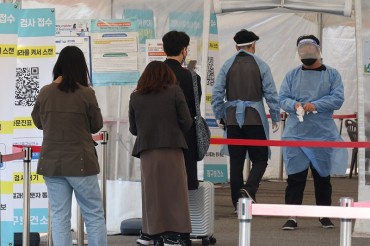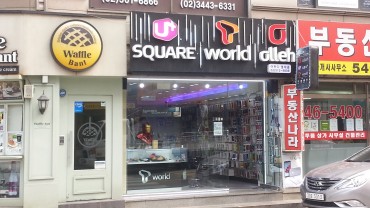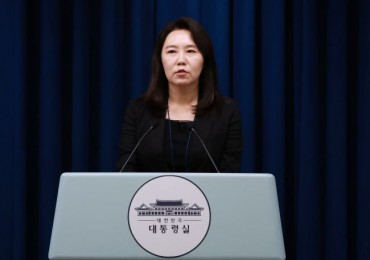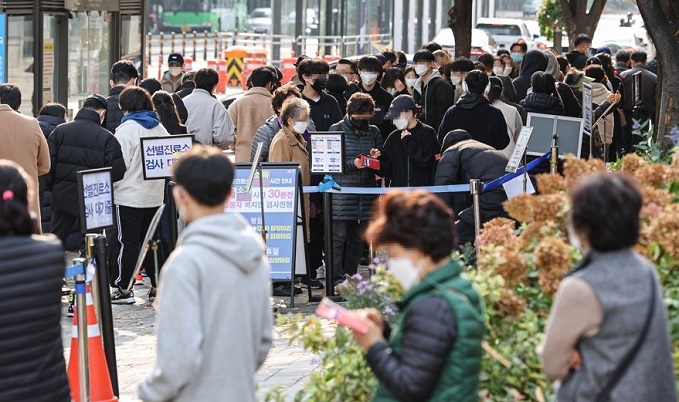
A coronavirus testing center in western Seoul is busy with people who came to get tested on Nov. 14, 2021. (Yonhap)
SEOUL, Nov. 15 (Korea Bizwire) — South Korea on Monday reported more than 2,000 daily coronavirus cases for six days in a row, fueling worries of a surge in COVID-19 infections after the country relaxed its virus-related restrictions early this month.
The country reported 2,006 new COVID-19 cases, including 1,986 local infections, raising the total caseload to 397,466, the Korea Disease Control and Prevention Agency (KDCA) said.
The number of daily cases has stayed in the quadruple digits since July 7, with the tally peaking at a record 3,270 on Sept. 25.
The country added 12 more deaths from COVID-19, bringing the death toll to 3,115. The fatality rate stood at 0.78 percent.
Of the 523 deaths over the past five weeks, 338 people, or 64.6 percent, were not vaccinated against the coronavirus.
As of 9 p.m. Monday, South Korea had reported 1,844 new cases across the country, down 23 from the previous day. The figure excluded cases from the southeastern city of Busan, which stopped releasing real-time data.
Cases are counted until midnight and announced the following morning.
Health authorities warned of a possible surge in daily infections and serious cases under the eased social distancing scheme aimed at bringing the country closer to pre-pandemic life.
On Nov. 1, the government began its “living with COVID-19″ policy as part of a broader plan to lift the virus restrictions by the end of February.
Under the first of the three-phase scheme, people are allowed to gather in groups of up to 10, regardless of vaccinations.
Limits on business hours for restaurants, cafes and movie theaters are fully lifted, except for adult entertainment facilities, such as clubs and bars.
The number of patients in critical condition reached 471 after jumping to an all-time high of 485 on Saturday.
Critically ill patients averaged 447 a day last week, up 22.5 percent from a week earlier. Of the total, people aged over 60 took up more than 82 percent.
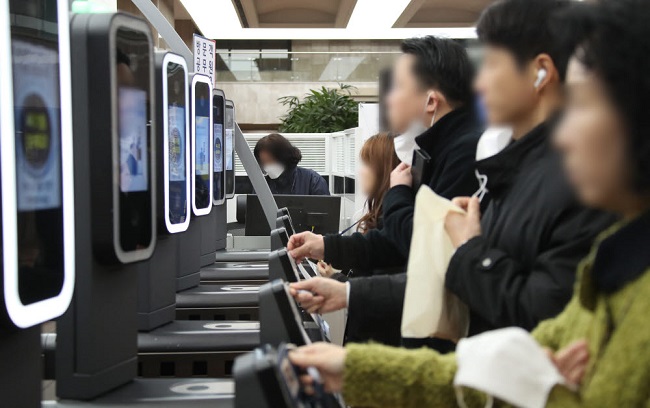
A facial recognition system for entering a government building resumes on Nov. 15, 2021, after being suspended for a while to help prevent the coronavirus from spreading. (Yonhap)
The hike in the number of patients in critical condition came after South Korea eased the virus rules.
The number of infected senior citizens rose as the effect of vaccinations has begun to taper down for those who received the shots earlier this year. Breakthrough cases at nursing homes and hospitals also increased.
The bed occupancy rate in intensive care units for COVID-19 patients rose 9.4 percent to 56 percent last week compared with the previous week.
The greater Seoul area saw its rate reaching 76.4 percent as of 5 p.m. Sunday, passing the benchmark of 75 percent set by the health authorities for possible enforcement of an emergency response plan.
The KDCA said it will unveil broad guidelines about such a plan Tuesday, but it will take emergency action, if necessary, “based on comprehensive assessments of the pandemic situation, not solely on numerical data,” Son Young-rae, a high-ranking official at the government agency, said during a briefing on Monday.
He also said growing cases among the elderly and rising severe infections are largely linked to the unvaccinated as well as waning vaccine effectiveness.
“Rather than strengthening social distancing rules again, we need to focus on speeding up vaccinations and making sure that high-risk facilities, like nursing homes, enforce health protocols more strongly,” he said, indicating that the government will not immediately return to stronger virus rules despite the continued spread of the coronavirus.
About 41.92 million people, or 81.7 percent of the country’s 52 million population, had received their first COVID-19 vaccine shots as of Sunday. The number of fully vaccinated people came to 40.1 million, or 78.1 percent.
The KDCA expects full vaccination rates to reach 80 percent around mid-December.
Of the total cases, Seoul reported new 859 cases, with 602 in the surrounding province of Gyeonggi and 102 in Incheon, a port city just west of Seoul.
The number of imported cases came to 20, raising the total to 15,390, the KDCA said.
(Yonhap)




